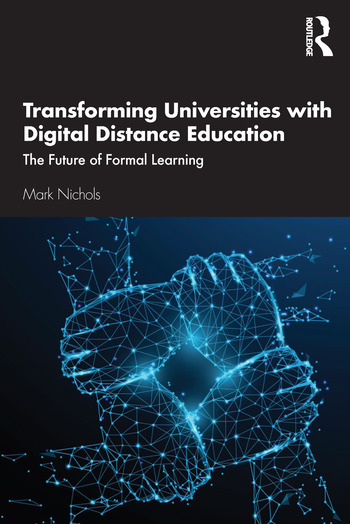New Book: Review of “Transforming Universities with Digital Distance Education” By Dr. Mark Nichols
Reviewed by: Farhad Saba, Professor Emeritus of Educational Technology, San Diego State University, Founder, Distance-Educator.com
Dr. Mark Nichols’ book provides a fresh look at the intersection between management and teaching roles of higher education at a critical time when institutions are scrambling to adjust to new realities of increasing costs, responding to rising diversity among students, and introducing new technologies to the teaching-learning process. There is also a growing concern among potential students about relevancy of attending college to their personal and professional lives. These factors make Transforming universities with digital distance education: The future of formal learning highly relevant to all professional educators. This is also the time of a worldwide pandemic, which has brought new challenges and perhaps opportunities to institutions of higher education. At this time the impact of the COVID-19 virus is not clear as universities have just begun to cope with this new problem and adjust to the realities that it has introduced. However, it seems that most institutions will have to expand their use of digital technologies to reach out to their students—an expansion which may be a permanent feature of their management as well as their teaching-learning practices in the future. Even traditional institutions which have been slow to adapt to their new environment are experiencing the effects of a diverse student population, increasing costs, and technological advancements under the conditions of the pandemic and will need to pay particular attention to how they will have to transform.
This book is written in a lucid and very accessible prose which makes it readable for all higher education professionals. Even though each specialty that is presented in the book has its unique terminology, the author cuts through such jargon to make it readily understandable by managers, learning designers, tutors and other professionals who strive to make higher education relevant to the needs of their learners at the time that the value of obtaining a university degree is under question.
For this very reason, the book starts with reminding the skeptics that education not only changes the lives of students, but it provides them immense economic opportunities and social benefits. To support these claims, Dr. Nichols reminds the reader of the simple axiom that the primary mission of higher education is linking learning to education! To make this linkage clear he asks four simple questions:
- Who are you going to educate?
- What qualifications, subjects and disciplines will you offer?
- What model(s) of education will you employ? and
- What roles will be involved in the education endeavour, and what will they do?
Answering these questions are very necessary, particularly, at a time that social environment of higher education is changing rapidly. What’s more, in some countries administrative states keep adding regulatory provisions to managing institutions of higher education which may or may not help them to fulfill their clear mission of linking learning to education. This direct linkage has also become further complicated by addition of various types of technologies each of which has added new dimensions to pedagogical approaches to teaching and learning.
To respond to these important questions Dr. Nichols offers the digital distance education model, or DDE, that provides an accessible, scalable and personalized model of teaching and learning, as well as managing. DDE achieves these ideals by consistency, and flexibility in its use of learning activities that are oriented towards the learner. Therefore the learner’s journey through the higher education experience constitutes the core of the model. To achieve this learner-centered model, data-analytics in a digitally agile environment is employed to allow educators implement evidence-based strategies in creating a rational and systematic teaching-learning environment. Chapter four presents detailed explanation of how educators can operationalize such an environment.
Chapter 5 provides context for operationalizing the model in four narratives each of which portrays the composite profile of a student with widely different backgrounds and professional interests. Each narrative explains different aspects of the DDE model in practice, and explains the experience of each student while going through the higher education journey. The narratives are rich in detail and provide the necessary framework to understand how the model works from the perspective of these diverse learners.
Dr. Nichols offers the digital distance education model or DDE that provides an accessible, scalable and personalized model of teaching and learning, as well as, managing.
The book, then, turns to teaching roles and further explicates key principles of DDE from the instructional perspective. Consistent with the style of the book, the author poses the simple but significant question of who is a teacher? Teaching roles in the DDE model include lead academics, learning activity designers, tutors, and the pastoral support staff. The activities and functions of each of these teaching roles are defined and are outlined in detail. The author recognizes that universities are unique in their varied approaches in teaching and learning. However, a single source of accountability for student success provides synchronicity between managing an institution and its primary teaching roles in the DDE model.
In chapter 7, the explanation of the DDE model turns to the concept of learning design. The author recommends the widest variety of learning activities to meet the primary requirements of the DDE model—accessibility, scalability, and personalization. To meet these requirements in a learner-centered environment, the chapter focuses on assessment which provides the necessary direction for pedagogical outcomes, regulating course and module design, and defining credentialing criteria at each level of educational attainment.
 As such, the requirements of DDE is comprehensive, and systemwide and impacts the entire operation of a university. To implement the model, therefore, it might be necessary for professionals to implement a process of organizational change. Chapter 8 provides the necessary strategy for such a process. Relying on his extensive experience in change management, Dr. Nichols presents a detailed explanation for organizational development towards implementing the DDE model. The agents of such a development process are not only those involved in teaching roles, but the entire university staff, in general, who are dedicated to fulfilling the educational and social responsibilities of their institution. To visualize the breadth, and depth of the reorganization process, the author offers several illustrations that guide the reader through various elements of a university that must work together to provide engagement, enlightenment and empowerment to students. Furthermore, an operating model canvas for an institution is presented that delineates the student journey through the university. Other necessary functions, ranging from the process of curriculum design and approval to adoption of a general strategy of management and governance are also presented and discussed in detail. These include enabling processes that make the organizational development for implementation of DDE possible. The visuals in Chapter 8 also include a detailed linear flow chart to guide the reader in understanding the relationship among the functions described and the impact of each function on the next function in line. The impetus for undertaking this overarching change process that encompass the entire university, however, is found in the increasing demand of learners for personalized learning . As such, learners are at the center of the demand for organizational change towards the ideals of DDE.
As such, the requirements of DDE is comprehensive, and systemwide and impacts the entire operation of a university. To implement the model, therefore, it might be necessary for professionals to implement a process of organizational change. Chapter 8 provides the necessary strategy for such a process. Relying on his extensive experience in change management, Dr. Nichols presents a detailed explanation for organizational development towards implementing the DDE model. The agents of such a development process are not only those involved in teaching roles, but the entire university staff, in general, who are dedicated to fulfilling the educational and social responsibilities of their institution. To visualize the breadth, and depth of the reorganization process, the author offers several illustrations that guide the reader through various elements of a university that must work together to provide engagement, enlightenment and empowerment to students. Furthermore, an operating model canvas for an institution is presented that delineates the student journey through the university. Other necessary functions, ranging from the process of curriculum design and approval to adoption of a general strategy of management and governance are also presented and discussed in detail. These include enabling processes that make the organizational development for implementation of DDE possible. The visuals in Chapter 8 also include a detailed linear flow chart to guide the reader in understanding the relationship among the functions described and the impact of each function on the next function in line. The impetus for undertaking this overarching change process that encompass the entire university, however, is found in the increasing demand of learners for personalized learning . As such, learners are at the center of the demand for organizational change towards the ideals of DDE.
Transforming Universities with Digital Distance Education is a much-needed book for all university professionals who are faced with an increasingly changing environment in which they operate. The Digital Distance Education (DDE) model offers the strategy to meet these challenges in an ever changing environment that is testing the relevance and resiliency of higher education.
Order the book from the publicher
Dr. Mark Nichols is a senior manager, leader and vocational, online and distance education professional with a valuable combination of experience across executive management,
*–My professional ‘Why’: Because formal education should be learning-centred, not supply-centred.–*
His academic contributions are presented in ORCID









